Chinese for Foodies: A Culinary Language Journey
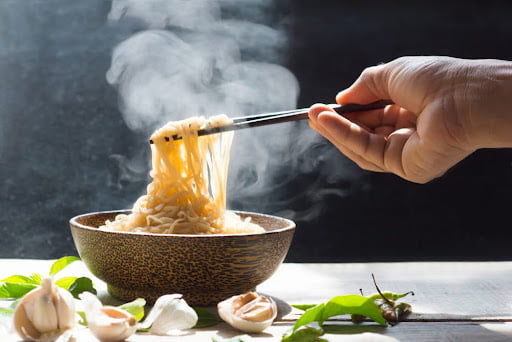
Are you ready to embark on a scrumptious and linguistic adventure through the diverse world of Chinese cuisine? Well, strap in, because we’re about to dive deep into the heart of China’s culinary landscape, where traditional Chinese food isn’t just about eating, it’s an experience, a culture, and a language all rolled into one delicious package.
China is a vast country, and so is its food scene. From the bustling streets of Beijing to the quiet corners of Chengdu, every region offers its own unique twist on food in China. This isn’t just about learning a few dishes. It’s about immersing yourself in the rich range of flavors and dialects that make up the Chinese culinary world.
Let’s face it, popular Chinese dishes like Peking Duck and Kung Pao Chicken have stolen hearts globally, but there’s so much more to explore. We’re going on a journey through different types of Chinese cuisine, each with its own history, ingredients, and, yes, linguistic quirks. Whether you’re drooling over dumplings or crazy about Cha Siu, knowing the right words can transform your dining experience.
So, grab your chopsticks (and maybe a notebook), as we spice up your language skills along with your palate. From ordering like a pro at a local dim sum joint to deciphering a street food vendor’s menu in a back alley of Shanghai, we’re about to unlock the secrets of Chinese cuisine and the language that brings it to life. Let’s get this culinary language journey started.
Related Reading: How to Order Chinese Food in a Chinese Restaurant
The basics of Mandarin for culinary enthusiasts
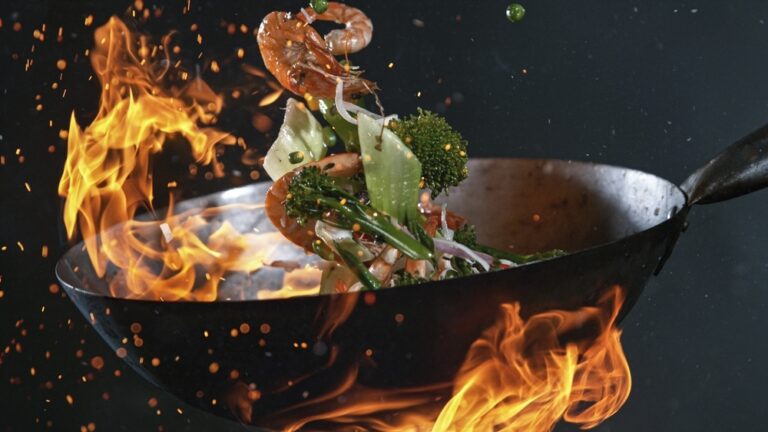
Welcome to the heart of our flavorful journey — the basics of Mandarin for all you food lovers out there. If you’re dreaming of diving headfirst into the world of Chinese cuisine, knowing a few key phrases can make all the difference. Whether you’re wandering through food markets in China or trying out traditional Chinese food at your local restaurant, these phrases are your secret ingredient to a more authentic and enjoyable experience.
Getting started with Mandarin
First things first, let’s talk about how to communicate your love for food in Mandarin. Start with the basics like “I like Chinese cuisine” — 我喜欢中国菜 (Wǒ xǐhuān zhōngguó cài). Easy, right? Remember, Mandarin is a tonal language, so getting the pitch right is as important as the pronunciation.
Ordering like a pro
Now, let’s get you ordering popular Chinese dishes like a native. To say “I want to order [dish name]”, you’d say “我想点 [菜名]” (Wǒ xiǎng diǎn [càimíng]). For example, “我想点宫保鸡丁” (Wǒ xiǎng diǎn gōngbǎo jīdīng) means “I want to order Kung Pao Chicken”. This simple phrase can be a game-changer in restaurants.
Exploring different types of Chinese cuisine
China’s culinary world is vast and diverse. From the spicy kick of Sichuan to the delicate flavors of Cantonese cuisine, each region brings something unique to the table. Learn phrases like “我喜欢川菜” (Wǒ xǐhuān chuāncài) for “I like Sichuan cuisine” or “我想尝试东北菜” (Wǒ xiǎng chángshì dōngběicài) — “I want to try Northeastern Chinese cuisine”. This shows your interest in food in China and your willingness to explore its rich variety.
Quick tips for tonal pronunciation
- Tones are crucial in Mandarin. Practice the four main Chinese tones: flat, rising, falling-rising, and falling.
- Listen to native speakers and mimic their pronunciation.
- Don’t worry about mistakes – enthusiasm and effort go a long way in learning and communicating.
Armed with these basic phrases, you’re well on your way to enjoying Chinese cuisine in a whole new way. Not only will you be able to navigate menus, but you’ll also connect more deeply with the rich, diverse culture behind every dish. So go ahead, be adventurous, and let your taste buds (and your new language skills) guide you through the delicious world of Chinese cuisine.
Remember, the joy of food is universal, and adding some Mandarin into the mix just makes it all the more delightful.
Related Reading: Debunked: Common Myths about Learning Chinese
Exploring Chinese cuisine through language
Alright, foodies, it’s time to step up our game. Chinese cuisine is like a grand, never-ending feast, and each region brings its unique flavors to the table. Let’s begin a linguistic food tour and savor the diversity of food in China. We’ll discover the magic behind traditional Chinese food and some popular Chinese dishes from various regions. Get ready to talk the talk as we walk through the delicious lanes of different types of Chinese cuisine.
The flavorful varieties of Chinese cuisine
Chinese cuisine isn’t just one style, it’s a range of tastes and techniques from different regions. From the spicy kick of Sichuan to the fresh seafood of Guangdong, every province has a story to tell through its food. Let’s get acquainted with some key regional cuisines:
Sichuan cuisine (川菜 Chuāncài)
Think spicy and bold flavors.
Famous dishes: Kung Pao Chicken (宫保鸡丁 Gōngbǎo Jīdīng), Mapo Tofu (麻婆豆腐 Mápó Dòufu).
Key words: 麻辣 (Málà — numbing and spicy).
Cantonese cuisine (粤菜 Yuècài)
Known for its dim sum and roasted meats.
Famous dishes: Dim Sum (点心 Diǎnxīn), Roast Duck (烧鸭 Shāoyā).
Key words: 清淡 (Qīngdàn — light and fresh).
Jiangsu cuisine (苏菜 Sūcài)
A more refined and elegant flavor profile.
Famous dishes: Sweet and Sour Mandarin Fish (松鼠桂鱼 Sōngshǔ Guìyú).
Key words: 鲜美 (Xiānměi — fresh and delicious).
Shandong cuisine (鲁菜 Lǔcài)
Known for its seafood and vinegary flavors.
Famous dishes: Braised Abalone (红烧鲍鱼 Hóngshāo Bàoyú).
Key words: 鲜香 (Xiānxiāng — fragrant and fresh).
Diving deeper into Chinese food culture
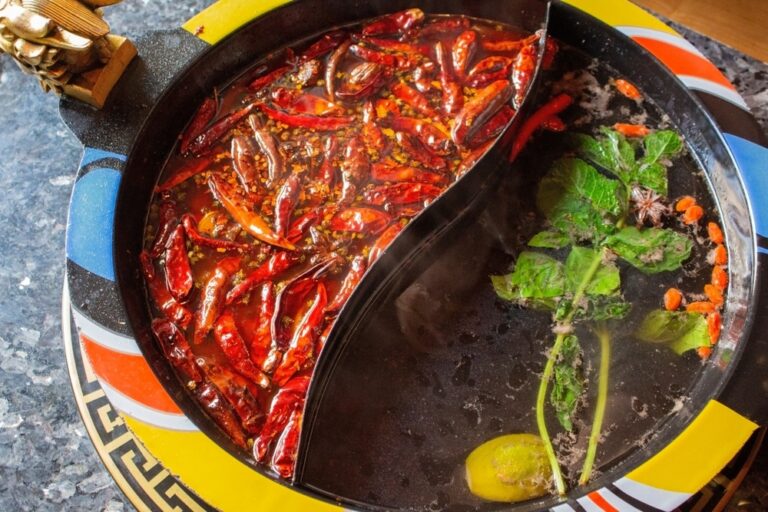
Chinese cuisine is deeply intertwined with its culture and history. Understanding a bit about the food culture can enrich your dining experience:
- Yin and yang in food: Balance is key in Chinese cooking. The concept of Yin (cooling foods like vegetables) and Yang (warming foods like meat) is often considered in meal preparation.
- Festival foods: Different festivals have specific foods associated with them, like mooncakes (月饼 Yuèbǐng) during the Mid-Autumn Festival.
The art of Chinese cooking
Each Chinese dish tells a story, often reflected in its name. Here are a few interesting ones:
- Buddha Jumps Over the Wall (佛跳墙 Fótiàoqiáng): A luxurious soup so delicious, it’s said to tempt even a Buddha.
- Ants Climbing a Tree (蚂蚁上树 Mǎyǐ Shàng Shù): A spicy Sichuan dish with ground meat clinging to noodles, resembling ants on twigs.
Engaging with locals
When exploring food in China, use these phrases to connect with locals and learn more about their cuisine:
What’s special about this region’s cuisine?
这个地区的菜有什么特色?(Zhège dìqū de cài yǒu shénme tèsè?)
Can you recommend a local dish?
你能推荐一个当地的菜吗?(Nǐ néng tuījiàn yīgè dāngdì de cài ma?)
There you have it. A peek into the rich and diverse world of Chinese cuisine. Remember, every dish you try is more than just a meal, it’s an insight into the culture and history of China. So, keep exploring, keep tasting, and most importantly, keep learning.
Related Reading: Drink like a Local — A Guide to Alcohol in China
Must-know culinary terms in Mandarin
When enjoying food in China or at your local Chinese restaurant, these phrases will come in handy:
“This is delicious!” — 这个很好吃!(Zhège hěn hǎochī!).
“Can I have the recipe?” — 我可以要这个食谱吗?(Wǒ kěyǐ yào zhège shípǔ ma?)
“A little spicier, please.” — 请多加点辣。(Qǐng duō jiā diǎn là.)
“I’m full, thank you.” — 我饱了,谢谢。(Wǒ bǎo le, xièxiè.)
Quick tips for Chinese food vocabulary
- Practice these words and phrases with a native speaker or through language learning apps.
- Watch cooking shows in Mandarin or try reading Chinese recipes to familiarize yourself with culinary terminology.
- When dining at Chinese restaurants, try identifying these terms on the menu to practice your skills.
With these terms and phrases in your culinary toolkit, you’re well-equipped to navigate the delicious realms of Chinese cuisine. So, go ahead, order with confidence, and immerse yourself in the flavorful world of Chinese food.
Exploring Chinese cuisine through its language isn’t just about tasting food, it’s about connecting cultures. Keep these phrases handy, and you’ll find that every meal is a new adventure in both taste and language.
Useful phrases for dining
- Asking for recommendations: “What is this restaurant’s signature dish?” — 这家餐厅的招牌菜是什么?(Zhè jiā cāntīng de zhāopái cài shì shénme?)
- Expressing dietary preferences: “I prefer less spicy food.” — 我喜欢吃不太辣的。(Wǒ xǐhuān chī bù tài là de.)
- Complimenting the meal: “This dish is delicious.” — 这道菜很好吃!(Zhè dào cài hěn hǎochī.)
- Asking for the bill: “Can we have the bill, please?” — 请给我们账单。(Qǐng gěi wǒmen zhàngdān.)
If you find yourself at a traditional Chinese banquet, you’re in for a treat. Here’s how to navigate it:
- Seating arrangement: Pay attention to the seating arrangement. The guest of honor usually sits facing the door, and the host sits next to them.
- Serving others: It’s polite to serve food to others before yourself, especially to elders or guests of honor.
- Sampling every dish: Try a little bit of everything. It’s a sign of appreciation for the variety and effort put into the meal.
Using these etiquette tips and phrases will not only enhance your dining experience but also show your respect for the rich traditions behind Chinese cuisine. So, go ahead, enjoy those sumptuous meals, and when in doubt, just follow the lead of your local dining companions.
Related Reading: The Importance of Pronunciation in Chinese
Street food and local delicacies in Chinese cuisine
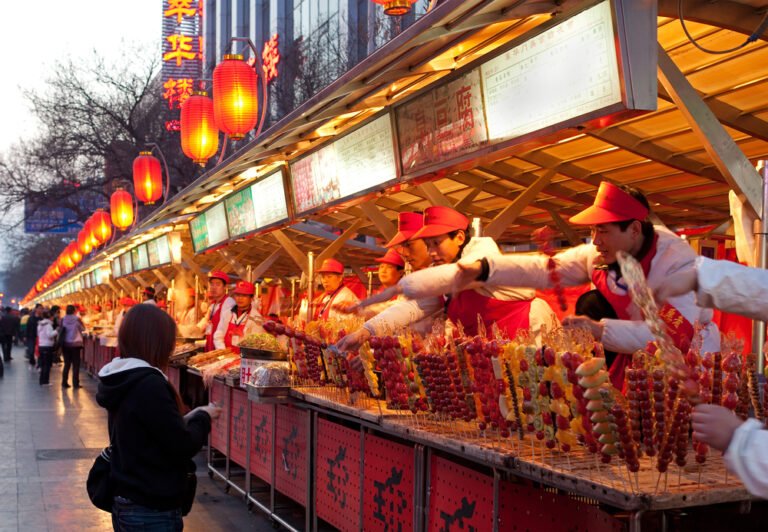
Ready to hit the streets? When it comes to Chinese cuisine, the streets are often where the magic happens. This is where traditional Chinese food meets everyday life. From sizzling woks to steaming baskets, street food in China offers an authentic taste of local flavors. Let’s take a stroll through the bustling markets and alleys to discover some popular Chinese dishes that you won’t find in fancy restaurants.
The world of Chinese street food
Jianbing (煎饼): A popular breakfast item, this is a savory crepe filled with eggs, green onions, and a variety of sauces and fillings.
Baozi (包子): These steamed buns filled with meat or vegetables are a perfect snack any time of the day.
Chuanr (串儿): Skewers of spiced, grilled meat — a must-try for meat lovers.
Zongzi (粽子): A traditional Dragon Boat Festival delicacy, these are sticky rice dumplings wrapped in bamboo leaves.
Flavors that define Chinese street food
Street food in China is all about bold flavors. Here are some key tastes you’ll encounter:
Spicy (辣 là): Sichuan and Hunan street foods often pack a spicy punch.
Sweet (甜 tián): Look out for sweet treats like red bean paste buns or candied fruits.
Savory (咸 xián): Soy sauce and five-spice powder bring a savory depth to many dishes.
Sour (酸 suān): Pickled vegetables and sour soups add a refreshing twist.
While street food is an integral part of food in China, here are some tips to enjoy it safely:
Look for Popular Stands: A long line is often a sign of good and safe food.
Watch the Cooking: Choose stands where food is cooked in front of you.
Be Adventurous, But Cautious: Try new things, but if you have food sensitivities, ask about ingredients.
Engaging with vendors
Use simple phrases to interact with street food vendors. It’s a great way to practice your Mandarin and learn more about the food:
“What’s popular here?” — 这里什么最受欢迎?(Zhèlǐ shénme zuì shòu huānyíng?)
“Can I have one with less spice?” — 可以少放点辣吗?(Kěyǐ shǎo fàng diǎn là ma?)
Chinese street food is a window into the soul of different types of Chinese cuisine. Every bite tells a story of tradition, innovation, and the daily life of locals. So, dive in, taste, and chat your way through the vibrant street food scene. Your culinary journey through China isn’t complete without it.
Related Reading: 50 Chinese Slang Words to Make You Sound Like a Native
Cooking and recipe language in Chinese cuisine
Let’s swap our chopsticks for chef’s hats and dive into the world of cooking Chinese cuisine. Ever been fascinated by the art of crafting traditional Chinese food at home? Whether you’re whipping up some popular Chinese dishes or experimenting with different types of Chinese cuisine, understanding the language of Chinese cooking will transform your kitchen experience. Let’s spice up your culinary vocabulary and get you ready to master some delectable recipes.
Basic cooking verbs and kitchen vocabulary
Chop (切 qiè): A fundamental skill in Chinese cooking, whether you’re slicing meat or chopping vegetables.
Stir-fry (炒 chǎo): The heart of many Chinese dishes, where ingredients are quickly cooked over high heat.
Steam (蒸 zhēng): A healthier cooking method, perfect for making buns, dumplings, and fish.
Deep-fry (炸 zhá): Used for dishes like spring rolls and crispy chicken.
Marinate (腌 yān): Essential for adding flavor to meats and vegetables before cooking.
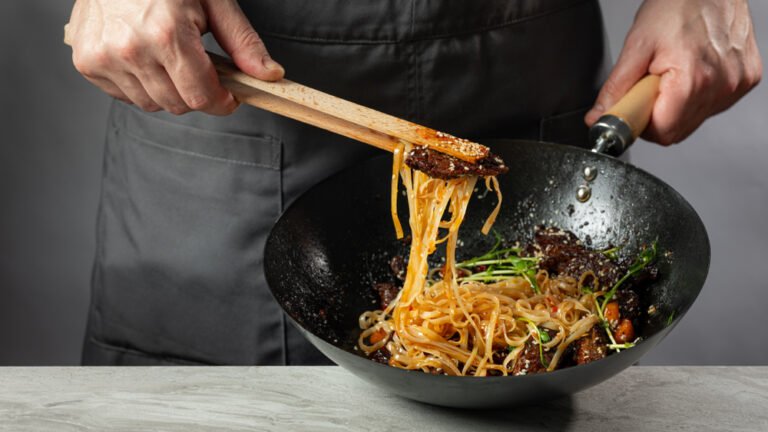
When you’re trying to follow a Chinese recipe, here are some key terms and measurements you might encounter:
Soy Sauce (酱油 jiàngyóu): A staple ingredient in many Chinese recipes.
Cornstarch (玉米淀粉 yùmǐ diànfěn): Often used for thickening sauces or coating ingredients.
Ginger (姜 jiāng): Adds a fresh, slightly spicy flavor to dishes.
Cup (杯 bēi) and tablespoon (汤匙 tāngchí): Common measurements in Chinese cooking.
Stir and mix (搅拌 jiǎobàn): Often used in instructions for combining ingredients.
Tips for cooking Chinese food at home
- Balance of flavors: Chinese cuisine is all about the harmony of flavors — sweet, sour, bitter, spicy, and salty.
- Prep work is key: Chinese cooking tends to be fast, so have all your ingredients chopped and ready to go.
- High heat cooking: A lot of Chinese dishes require cooking at high temperatures for that authentic wok hei (the breath of the wok).
- Experiment: Don’t be afraid to try your hand at different recipes or tweak them to your taste.
Engaging in culinary conversations
When discussing cooking or sharing recipes, use phrases like:
“How do you make this dish?” — 这道菜怎么做?(Zhè dào cài zěnme zuò?)
“What’s the secret to this flavor?” — 这个味道的秘诀是什么?(Zhège wèidào de mìjué shì shénme?)
Cooking Chinese food isn’t just about feeding the stomach, it’s about feeding the soul. As you explore the language of Chinese cooking, you’ll find yourself getting closer to the heart of Chinese culture. So, go on, heat up that wok, and let the flavors of China dance in your kitchen.
Remember, the journey through Chinese cuisine is endless. Each dish you cook is a new chapter in your culinary story. Have fun in the kitchen and share your creations with friends and family – there’s no better way to enjoy the richness of Chinese food culture.
Related Reading: How Many Mandarin Words Do I Need to Learn to Be Fluent?
Cultural insights: Festivals, food, and language in Chinese cuisine
Next up, let’s dive into the colorful world of Chinese festivals and how they intertwine with Chinese cuisine. Celebrations in China aren’t just about vibrant festivities, they’re deeply rooted in traditional Chinese food. Each festival has its unique array of dishes, symbolizing luck, prosperity, and family unity. In this section, we’ll unwrap some of these cultural treasures and the language that goes with them.
Festival foods and their meanings
Chinese New Year (春节 Chūnjié)
Dumplings (饺子 Jiǎozi): Symbolizing wealth and prosperity. Families often gather to make them together.
Phrase to know: “Happy New Year!” — 新年快乐!(Xīnnián kuàilè!)
Mid-Autumn Festival (中秋节 Zhōngqiūjié)
Mooncakes (月饼 Yuèbǐng): Round cakes representing reunion and completeness. They come in various fillings like red bean or lotus seed paste.
Phrase to know: “Enjoy the Mooncakes.” — 享受月饼!(Xiǎngshòu yuèbǐng.)
Dragon Boat Festival (端午节 Duānwǔjié)
Zongzi (粽子 Zòngzi): Sticky rice dumplings wrapped in bamboo leaves, often filled with meat or sweet red beans.
Phrase to know: “Let’s watch the dragon boat race.” — 我们去看龙舟比赛吧. (Wǒmen qù kàn lóngzhōu bǐsài ba.)
The role of food in Chinese celebrations
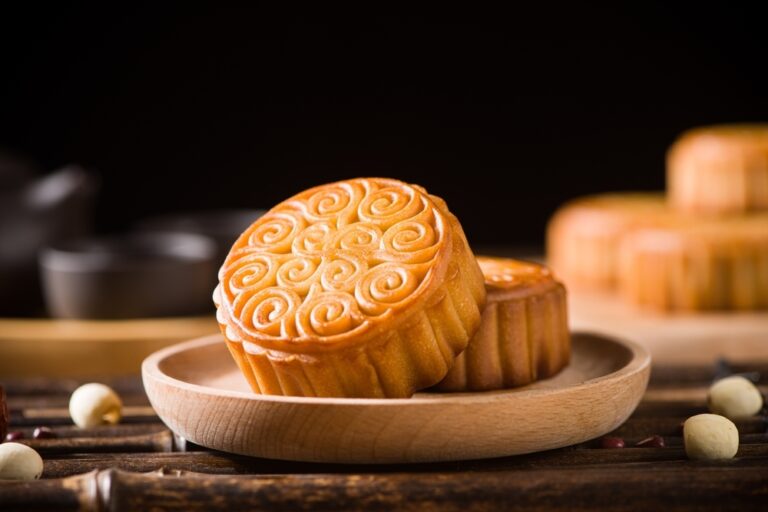
Food in Chinese celebrations goes beyond mere consumption. It’s a vehicle for storytelling, honoring ancestors, and expressing good wishes. From the intricate designs on mooncakes to the careful preparation of zongzi, each aspect of these foods holds cultural significance.
Cultural tips for festival participation
- Gift giving: If you’re invited to a Chinese celebration, consider bringing a food-related gift. Gifts of Chinese tea, fruits, or sweets are always appreciated.
- Participating in traditions: Engage in the customs — help make dumplings or learn the stories behind the festival dishes.
- Language and interaction: Use these occasions to practice your Mandarin. Express interest in the stories and meanings behind each dish.
Exploring the festivals of China through their cuisine is a delightful journey into the heart of Chinese culture. Remember, each bite you take is steeped in history, tradition, and collective joy. So, enjoy the festivities, savor the food, and immerse yourself in the exciting world of Chinese cultural celebrations.
Festivals in China are a kaleidoscope of flavors, colors, and stories. As you dive into these cultural feasts, you’re not just eating, you’re partaking in a millennia-old legacy. Enjoy every moment, and let your taste buds and heart be your guide.
Related Reading: The Mandarin Blueprint Guide to Chinese Festivals
Learning resources and tips
You’ve journeyed through the flavors and traditions of Chinese food, and now you might be wondering, “How can I continue exploring and learning more?” Fret not. This section is all about resources and tips to deepen your understanding and appreciation of the diverse culinary landscape of China. Let’s get you equipped.
Online resources and apps
- Cooking websites and blogs: Websites dedicated to Chinese cuisine offer a wealth of recipes and cooking tips. Try to find ones that also focus on language.
- YouTube channels: Look for channels that focus on Chinese cooking. Some of them even teach you the language while cooking.
Books and cookbooks
- Chinese cookbooks: Invest in a good cookbook that not only has recipes but also talks about the history and culture behind the dishes.
- Language books: Books that focus on Mandarin for travelers or food lovers can be very handy.
Engaging with the Community
- Cooking classes: Check if there are any Chinese cooking classes in your area. It’s a great way to learn about different types of Chinese cuisine hands-on.
- Language exchange: Find a language exchange partner who is interested in cooking. You can learn Mandarin while they learn your language, and you both can share recipes.
Practice makes perfect
- Try cooking at home: Pick a recipe each week and give it a go. It helps in understanding the food and language simultaneously.
- Restaurant visits: Use your new language skills when visiting Chinese restaurants. Try ordering in Mandarin or asking questions about the menu.
- Travel: If you have the opportunity, visit China. There’s no better way to experience food in China than being there and engaging with the culture firsthand.
And there you have it. A treasure trove of resources and ideas to keep you busy in your quest to master the art of Chinese cuisine. Remember, every step in this journey isn’t just about food, it’s about culture, language, and connection. So, keep learning, keep cooking, and most importantly, keep enjoying the delicious world of Chinese cuisine.
Related Reading: Best Resources for Learning Chinese
The culinary road to fluency in Mandarin
As we wrap up this scrumptious journey through the diverse and tantalizing world of Chinese cuisine, it’s clear that the path to understanding and appreciating this rich culinary heritage is intertwined with the language that gives it life. From savoring street food to celebrating traditional festivals, every bite of Chinese cuisine is a step closer to cultural immersion.
Whether you’re a foodie, a language learner, or both, the world of Chinese cuisine offers an endless banquet of learning and enjoyment.
But why stop here? Your journey into the heart of Chinese cuisine and language has just begun. Maybe you’ve discovered a newfound love for Sichuan spices or found yourself dreaming in Mandarin about juicy soup dumplings. Whatever your experience, there’s so much more to explore and learn.
Ready to take your Mandarin skills to the next level with a fun and engaging twist? Want to learn Mandarin faster and easier, tailored specifically to your personal interests in Chinese cuisine? Here’s your chance to get a comprehensive understanding of where you stand and how you can improve.
Complete the FREE Mandarin Fluency Scorecard. This isn’t just any assessment, it’s a personalized journey into your language skills, focusing on areas where you can grow and excel.
Don’t miss this opportunity to blend your love for Chinese cuisine with your language learning ambitions. Click below and take your first step towards a more fluent, more flavorful Mandarin learning experience.
Embrace the journey, and remember, every dish you learn to cook and every phrase you learn to speak brings you closer to the heart of Chinese culture. Here’s to delicious dishes and fluent conversations.








